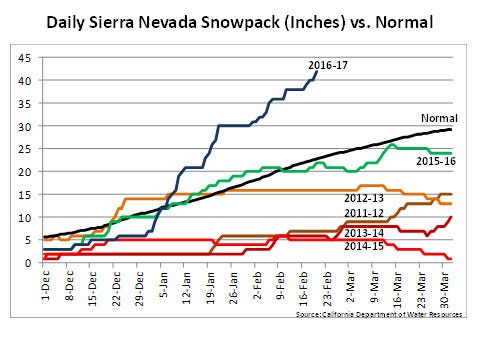Data show disappearance of D3/D4 drought in California.

U.S. Department of Agriculture chief economist Dr. Robert Johansson reported this week that extreme to exceptional (D3 to D4) drought conditions in the U.S. have fallen to their lowest point in more than six years. Nowhere is that change more dramatic than in California, he said.
The Feb. 21 “Drought Monitor” for California noted the disappearance of D3/D4 conditions from California. At the California drought’s peak from August to October 2014, that level was nearly 82%. As recently as early-December 2016, coverage of D3/D4 in California still stood at 43%.
Johansson said the five-year drought caused the death of more than 100 million trees, mostly in the central and southern Sierra Nevada. Row crop acreage in California also declined from 4.27 million acres in 2010-12 to 3.23 million acres in 2014-16.
While economic impacts of the California drought are difficult to calculate, Johansson noted that University of California researchers estimate that the drought in 2016 alone resulted in a $247 million loss in farm-gate revenues and 1,815 full-time and part-time jobs. With spillover effects to other parts of the economy, total impacts are estimated to be 4,700 full- and part-time jobs and $600 million in sector output losses. Those costs were likely higher in 2014 and 2015 due to the more severe drought conditions.
Data from the California Department of Water Resources indicated that the snow that fell across the Sierra Nevada just in January contained an average of 2 ft. of liquid — more than 80% of the normal seasonal total (Figure). Add to that the snow that accumulated from October to December 2016 and during the first three weeks of February, and the Sierra Nevada is ensured of an above-average snowpack for the first time in six years when the traditional peak snowpack date arrives on April 1.

“While most decisions about water allocations are made at the state level, the abundance of precipitation during California’s wet season, the promise of abundant, snowmelt-driven spring and summer runoff and an already dramatic increase in statewide reservoir storage all bode well for a general easing of water restrictions in the wake of the five-year drought and for agriculture in general, the largest user of California’s stored water,” Johansson said.
California is the most productive agricultural state in the nation, with more than $47 billion in cash receipts and $14.5 billion in net farm income in 2015. Its largest sectors include dairy (sales of about $6.3 billion), almonds (sales of more than $5.3 billion) and grapes (sales of nearly $5 billion).
Johansson noted that crop insurance indemnities for California crops doubled in 2014 to about $380 million and nearly doubled again in 2015 to $622 million before falling back to $250 million in 2016. Pre-drought indemnities typically averaged around $115 million in the 10-year period from 2004 to 2013.
About the Author(s)
You May Also Like



